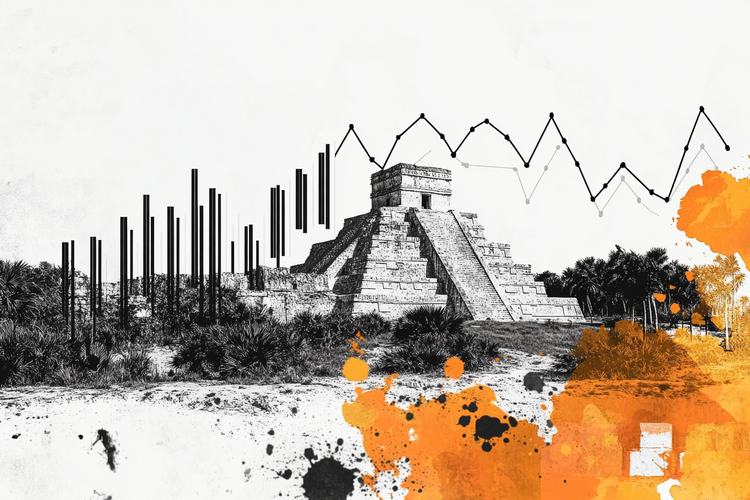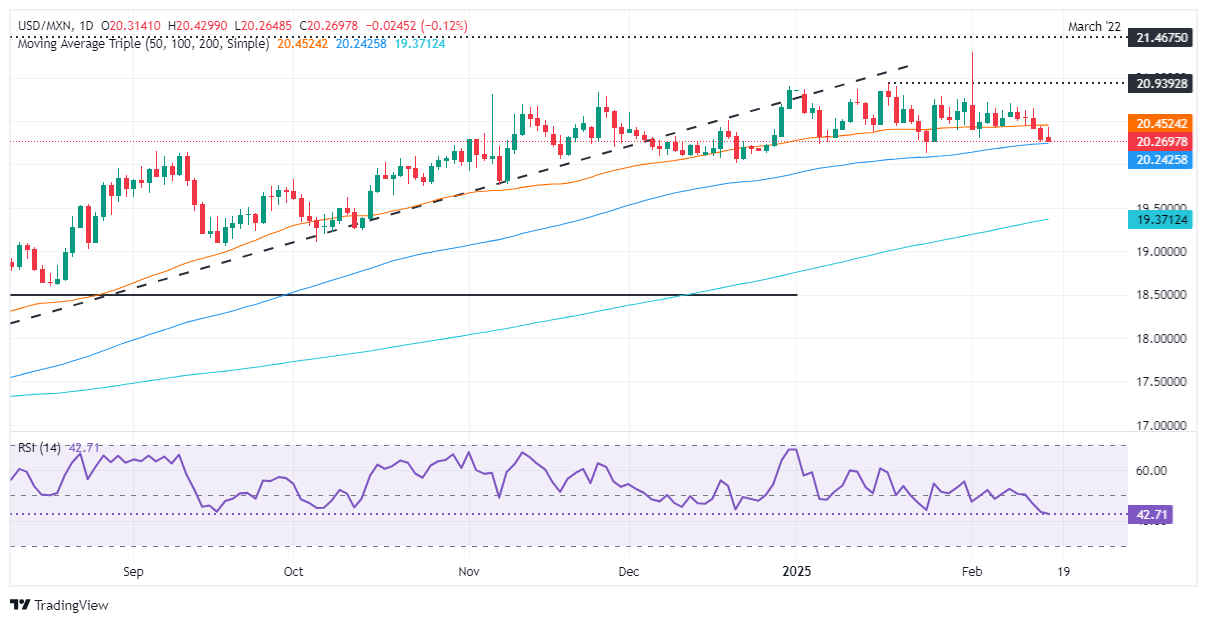Products You May Like
- USD/MXN dips below 50-day SMA at 20.42, trading at 20.27.
- Weak US Retail Sales and softer PPI sub-components fuel Fed easing expectations.
- Mexico’s Retail Sales, Banxico minutes, and Q4 GDP are in focus this week.
The Mexican Peso (MXN) extended its gains versus the US Dollar (USD), clearing key support at the 50-day Simple Moving Average (SMA) of 20.42 as the USD/MXN found acceptance at lower exchange rates. At the time of writing, the exotic pair trades at 20.27, down 0.09%.
Last week’s worse-than-expected United States (US) Retail Sales report drove the USD/MXN pair lower amid the uncertainty about economic growth in the US.
Although US consumer inflation data surged, some sub-components of the Producer Price Index (PPI) used to calculate the Federal Reserve’s (Fed) preferred inflation gauge, the Core Personal Consumption Expenditures (PCE) Price Index, suggests that prices could aim lower, increasing the chances for Fed’s easing.
After Friday’s data, figures from the Chicago Board of Trade (CBOT) suggest that investors had priced in 43 basis points (bps) of easing.
Despite this, the Philadelphia Fed President Patrick Harker stated that the current state of the economy justifies maintaining a steady rate policy, noting that monetary policy is well-positioned now. He acknowledged that inflation has remained elevated and persistent in recent months, emphasizing that the Fed’s policy stance should continue to work towards lowering inflation.
Ahead of this week, Mexico’s economic docket will feature Retail Sales for December, the release of Banco de Mexico (Banxico) latest meeting minutes, and Gross Domestic Product (GDP) figures for Q4 2024.
Daily digest market movers: Mexican Peso climbs despite Banxico’s dovish stance
- Monetary policy divergence between Banxico and the Fed favors further USD/MXN upside, as the Fed would likely hold rates for a longer period, while Banxico is expected to cut rates again by 50 basis points in the next meeting.
- The US Dollar Index (DXY), which tracks the buck’s performance against a basket of currencies, is virtually unchanged at 106.77, a headwind for USD/MXN.
- Trade disputes between the US and Mexico remain in the boiler room. Although the countries found common ground previously, USD/MXN traders should know that there is a 30-day pause and that tensions could arise toward the end of February.
USD/MXN technical outlook: Mexican Peso surges as USD/MXN drops below 50-day SMA
USD/MXN trends lower on Monday and close into the 100-day SMA at 20.24, which, if cleared, could open the door for further downside. The Relative Strength Index (RSI) turned bearish, which indicated that the exotic pair could be headed to the 20.00 psychological figure.
In that outcome, if sellers push prices below 20.00, the next support would be the October 18 swing low at 19.64, followed by the 200-day SMA at 19.37.
Conversely, if USD/MXN rises back above the 50-day SMA, the next resistance would be 20.50, followed by the January 17 high of 20.90, the 21.00 figure, and the year-to-date (YTD) high of 21.29.
Mexican Peso FAQs
The Mexican Peso (MXN) is the most traded currency among its Latin American peers. Its value is broadly determined by the performance of the Mexican economy, the country’s central bank’s policy, the amount of foreign investment in the country and even the levels of remittances sent by Mexicans who live abroad, particularly in the United States. Geopolitical trends can also move MXN: for example, the process of nearshoring – or the decision by some firms to relocate manufacturing capacity and supply chains closer to their home countries – is also seen as a catalyst for the Mexican currency as the country is considered a key manufacturing hub in the American continent. Another catalyst for MXN is Oil prices as Mexico is a key exporter of the commodity.
The main objective of Mexico’s central bank, also known as Banxico, is to maintain inflation at low and stable levels (at or close to its target of 3%, the midpoint in a tolerance band of between 2% and 4%). To this end, the bank sets an appropriate level of interest rates. When inflation is too high, Banxico will attempt to tame it by raising interest rates, making it more expensive for households and businesses to borrow money, thus cooling demand and the overall economy. Higher interest rates are generally positive for the Mexican Peso (MXN) as they lead to higher yields, making the country a more attractive place for investors. On the contrary, lower interest rates tend to weaken MXN.
Macroeconomic data releases are key to assess the state of the economy and can have an impact on the Mexican Peso (MXN) valuation. A strong Mexican economy, based on high economic growth, low unemployment and high confidence is good for MXN. Not only does it attract more foreign investment but it may encourage the Bank of Mexico (Banxico) to increase interest rates, particularly if this strength comes together with elevated inflation. However, if economic data is weak, MXN is likely to depreciate.
As an emerging-market currency, the Mexican Peso (MXN) tends to strive during risk-on periods, or when investors perceive that broader market risks are low and thus are eager to engage with investments that carry a higher risk. Conversely, MXN tends to weaken at times of market turbulence or economic uncertainty as investors tend to sell higher-risk assets and flee to the more-stable safe havens.

